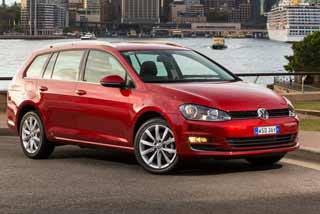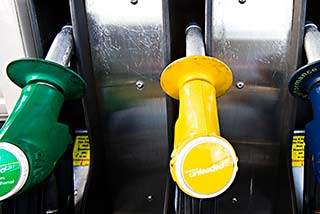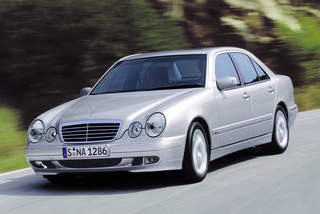 Click for more photos
Click for more photos
Interiors of the future
The unconventional layout in the Mercedes-Benz F125.
It is the paradox of the modern car interior: in introducing the latest cutting-edge technologies, designers have historically been hamstrung with dated design layouts.
Look at many of the latest luxury and mainstream offerings and you'll find boxy switchgear configurations adorned with myriad buttons and switches, confusing the driver and occupants.
There's also the problem of larger vehicle dimensions and kerb weights brought about by necessary packaging and infrastructure needed to support the so-called iPod age.
However, the next few years are likely to revolutionise your driving environment, as designers work to harmonise form and function.
The silver bullet, rather ironically, will be more technology, according to the biggest names in global car design.
Changes are already apace. Tablet-style touchscreens, optical displays and voice recognition are being increasingly integrated into interior design. In addition, central rotary dials which reduce the switchgear count are now commonplace in many cars including the Mazda3, and conventional hardware such as handbrakes and gearsticks are being eschewed for electric or pop-up configurations. Ferrari has even gone as far as deleting indicator stalks and other switchgear from its interiors by moving controls onto the steering wheel, inspired by the latest formula one layouts.
BMW kick-started the streamline craze back in 2001 when it debuted the iDrive rotary controller in the 7-Series, allowing users to control climate, audio and navigation amenities through one controller knob mounted on the centre console rather than a series of buttons, dials and knobs.
The latest Range Rover Sport takes the concept even further. Released last year, the new model has received intuitive dials and colour screens to achieve a
55 per cent reduction in switchgear on the previous model.
The car interior of the future will take this concept to a new paradigm, being more intuitive, more comfortable, more digital and, above all else, more practical.
"You shouldn't get into the driver's seat of a car and feel like you're flying a 747," Land Rover chief designer Gerry McGovern tells Fairfax Media. "That's a natural progression and it's something that we're very focused on in terms of giving customers more and making our vehicles more unique.
"We're looking at technology that's design enabling and what I mean by that is that they should work [together]."
Peter Schreyer, the global design boss at Hyundai and Kia, agrees the humble interior has been neglected in the past because of an increasing focus on technology.
"Interior has gotten more complex because of all the electronics and safety things," he says. "When you buy a car or you see it on the street you like it, you want it. Then you don't want to have a disappointment, you want to have a nice surprise. It's very important interior and exterior harmonise together and it's one product.
"I like to give a lot of attention to interiors, it's very important."
To coincide with the growing emphasis on in-car design, auto makers are appointing creative types specifically to focus on their interiors.
In-car layouts are also taking higher precedence during the design process of a new car, a factor which will be reflected in the next generation of vehicles.
"It is indicative of us … finally realising the importance of interiors," says Moray Callum, Ford's global vice president of design.
"As we say people fall in love with the exterior but they live with the interior. We're putting a lot more care and time in accommodation and usage of the interiors … [spending more time on design inside the car] and starting earlier and planning better as well."
Ford recently appointed its first global head of interiors and is actively seeking feedback from customers on where its interior designs can improve for more liveable and comfortable layouts.
"We also think in the past we've overdone the technology side in terms of giving people more information than they might need or giving them the opportunity to have more information that they might need," Callum admits, possibly in reference to the button-laden dashboard layouts of the Ford Fiesta, Focus and EcoSport SUV. "Just because you can do it doesn't mean to say you need to do it.
"We need to get into that right position where we've got the right switches for the right customer in the right place but not overload it.
"People are looking for something less intimidating when it comes to the interior. People are looking to say how can we simplify that visually but how can we make it still intuitively very usable."
Here, we outline six interior design themes that are likely to materialise in the not-too-distant future.
Gesture control
Arguably the most revolutionary change in store for car interiors, gesture control will also be the most challenging.
The technology is similar to that used on gaming consoles that mimic movements in a virtual environment. It will work by having a stereo camera within the cabin (in the rear-view mirror for example) that can recognise certain movements for pre-programmed adjustments and functions.
Hyundai showed the first automotive application of gesture command in its HCD-14 concept at the 2013 Detroit motor show, a car that previewed its new Genesis luxury sedan. Mercedes-Benz used the same technology on its F 125 experimental vehicle to open its gullwing doors.
Land Rover has more recently explored the capabilities of gesture control during the development of its Discovery Vision Concept unveiled at last month's New York auto show.
The concept did away with conventional hardware items such as steering-wheel mounted indicator stalks and door handles. Instead, those functions were said to be triggered through a camera recognising pre-programmed movements from the driver and occupants.
Gesture control will have a two-pronged effect, simplifying interior design and leaving more space for storage options. In the case of the Discovery Vision Concept, Land Rover designers enabled more space for storage items, including detachable suitcases attached to the door sleeves.
Connectivity
Imagine your car knows exactly what time you need to leave for work and is ready to go, the engine warmed, cabin dialled at exactly the right temperature and the sat nav set for your destination.
Once the preserve of high-end luxury vehicles, this technology is now beginning to flow down to more mainstream models.
BMW just last week announced the rollout of its ConnectedDrive service in Australia, enabling cars - with a subscription - to be monitored remotely by the dealer, automatically booked into services or call authorities if involved in an accident. The feature, to be available in cars built from March, will be operated via a permanently installed SIM card which allows the flow of data and voice transfer to and from the vehicle.
Rather than solely developing their own infotainment and display systems, car makers are now actively working with third-party groups such as Apple and Google to integrate the latest technology. Under such systems, users will be able to directly access apps downloaded on their phone and upgrade their software with a simple download.
Handwriting/fingerprint recognition
Still in its infancy, handwriting and fingerprint technology is set to revolutionise the way we secure and operate our vehicles.
BMW's iDrive Controller, fitted in vehicles such as the X5 SUV, already allows users to search satellite-navigation with their own handwriting.
The system builds on technology introduced by Audi in 2010. The German brand's A8 flagship pioneered a satellite navigation system that recognised handwriting, so drivers could scribble addresses directly into the system rather than having to punch in the individual letters from a virtual keyboard.
Several offerings on the market also offer fingerprint recognition. A sensor in the start button on the dash can identify different fingerprints and adjust the car's seating, radio and air-conditioning controls to the driver's pre-determined "favourite" settings.
"Smart" keys once limited to luxury vehicles are now finding their way onto entry offerings, allowing the driver to open the car without touching the key fob.
Smarter materials
Washable and stain-resistant materials will likely be an inherent feature in future car interiors.
The current trends towards leather and alcantara will likely persist, but those materials will be more durable while still retaining their softness.
If Mercedes-Benz's lead is any guide, then you can also expect more of a focus on scented interiors, or even a take-off of the German brand's S-Class cabin filtration system. It ionises incoming air and automatically closes the vents when it senses a tunnel, using the car's in-built GPS system.
Virtual instrument panels
This particular technology is more prevalent than you may think.
The Holden Commodore and Mazda3 already boast head-up displays, while Volvo's V40 features a clever digital instrument cluster which does away with conventional needles and dials.
The latter uses the same thin-film transistor (TFT) technology used on laptops, mobile phones and computer games, providing excellent clarity and contrast and improving the visibility of the instruments.
The big game changer is due to arrive next year in the form of Audi's next-generation TT. The new model features a driver-oriented virtual cockpit display. It's a fully digital instrument cluster displaying all the information directly in front of the driver.
There is no need for a conventional multimedia interface (MMI) screen in the centre of the fascia. This fresh approach gave the Audi designers the freedom to slim down the instrument panel architecture.
The virtual cockpit display has superb graphics with a 3D impression and detailed effects of great clarity on a 12.3-inch TFT monitor which handles all of the TT's infotainment functions.
The latest systems allow drivers to personalise their panel to meet their own requirements, including whether the speedo display is set in miles per hour or kilometres per hour.
Display fonts, colours and styles can be changed, depending on taste. This trend paves the way for dashboard displays becoming completely personalised, with a capability to change the background picture as you would on your smartphone or computer desktop.
The most extreme example of virtual instrument panels is a smart glass application recently unveiled by Land Rover.
According to the British brand: "The smart glass in the window can work in conjunction with eye-tracking sensors and the vehicle's sat-nav system to identify that, for instance, a passing landmark is being observed by one of the vehicle's passengers - and displays relevant information, such as navigation or tourist data, to that passenger.
"That information can then be swiped from the window directly into a passenger's seatback infotainment screen, or - adding in the functionality of passengers' personal devices - even to a docked tablet or smartphone."
The smart glass technology can also be used in the panoramic roof to display screen-saver style ''mood screens'', such as a starry night sky or a clear blue summer's day.
Seating layouts
The conventional five-seat layout is likely to be a casualty of the interior revolution, particularly in larger cars.
People movers such as the latest Honda Odyssey have ditched conventional layouts for adjustable configurations which slide backwards and forwards, even offering fold-out ottomans or ''captain's pews''.
The seven-seat Land Rover Discovery Vision Concept unveiled in New York took that idea to another level, its 2+3+2 layout offering four different seating configurations including a four-seat limo mode.
To accommodate these sort of seating layouts, designers are removing conventional design functions such as the park brake and gear stick and replacing them with electronically controlled features which pop out of the centre binnacle and subsequently free up room.
With Toby Hagon








































9 comments so far
New user? Sign up
Make a comment
You are logged in as [Logout]
All information entered below may be published.
Thank you
Your comment has been submitted for approval.
Comments are moderated and are generally published if they are on-topic and not abusive.